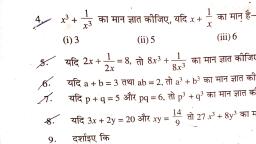Question 1 :
When a glass rod is rubbed with silk, the charge acquired by the silk is :<br><br>
Question 3 :
State whether true or false :Electric field calculated by a Gauss law is the field due to only those charges which are enclosed inside the Gaussian surface.
Question 6 :
On doubling the charge on one particle while leaving all other factors the same will:<br/>
Question 7 :
A charge is kept at the centre of a shell. Shell has charge Q uniformally distibuted over its surface and radius R. The force on the central charge due to the shell is :
Question 8 :
Negative electric flux indicates that electric lines of force are directed
Question 9 :
Assertion: A charge $q$ is placed on a height $h / 4$ above the centre of a square of side $b$. The flux associated with the square is independent of side length.
Reason: Gauss's law is independent of size of the Gaussian surface.
Question 11 :
<p>An electric dipole moment $\overrightarrow {\rm{P}} {\rm{ = }}\left( {{\rm{2}}{\rm{.0}}\widehat {\rm{i}}{\rm{ + 3}}{\rm{.0}}\widehat {\rm{j}}} \right){\rm{\mu C}}{\rm{.}}$.m is placed in a uniform electric<br>field$\overrightarrow E {\rm{ = }}\left( {{\rm{3}}{\rm{.0}}\widehat {\rm{i}}{\rm{ + 2}}{\rm{.0}}\widehat k} \right) \times {10^5}$</p>
Question 12 :
Electric field due to an infinite sheet of charge having surface density $\sigma$ is $E$. Electric field due to an infinite conducting sheet of same surface density of charge is
Question 13 :
A soild sphere of radius $ R_1 $ and volume charge density $ \rho=\frac { \rho_0 o }{ r } $ is enclosed by a hollow sphere of radius $ R_2 $ with negative surface charge density $ \sigma $, such that the total charge in the system is zero. $ \rho_0 $ is a positive constant and r is the distance from the center of the sphere.Then the ratio$ R_2 / R_1 $ is
Question 14 :
A body has a charge of $-2 \mu C$. If it has $2.5 \times {10}^{13}$ protons, then how many electrons the body has?
Question 15 :
Two point charge -q and +q/2 are situated at the origin and the point (a,0,0) respectively. The point along the X-axis where the electric field vanishes is 
Question 16 :
Two positive point charges $q$ are placed at  $(a,0)$ and $(-a,0)$. A third positive charge $q_o$ is placed at $(0,y)$. For what value of $y$, the force on $q_o$ is maximum?
Question 17 :
A charged oil drop is suspended in uniform field of $3\times 10^4V/m$ so that it neither falls nor rises. The charge on the drop will be: (Take the mass of the charge $=9.9\times 10^{-15}$kg and $g=10m/s^2$)
Question 18 :
<span class="wysiwyg-font-size-small"><span class="wysiwyg-font-size-small"><p class="wysiwyg-text-align-left">If the force between two charged objects is to be left unchanged even though the charge on one of the object is halved keeping the other same, the original distance (d) of separation should be changed to :<br/></p>
Question 19 :
Two small identical spheres having charges $+10\mu C$ and $- 90\mu C$ attract each other with a force of $F$ Newton. If they are Kept in contact and then separated by the same distance, The new force between them is:
Question 20 :
The force between two charges $2\mu C$ and $4\mu C$ is $24 N$, when they are separated by a certain distance in free space. The forces if, $(a)$ distance between them is doubled and $(b)$ distance is halved are :
Question 21 :
Charges $Q_1$ and $Q_2$ are placed inside and outside respectively of an uncharged conducting shell. Their seperation is r.
Question 23 :
Charges $Q_1$   and  $Q_2$ lie inside and outside, respectively, of a closed surface S. Let E be the field at any point on S and $\phi$ be the flux of E over S.
Question 24 :
Two parallel large thin metal sheets have equalsurface charge densities$\displaystyle \left( \sigma =26.4\times { 10 }^{ -12 }{ c }/{ { m }^{ 2 } } \right)$ of opposite signs.<br>The electric field between these sheets is:<br><br>
Question 25 :
A system consists of a thin charged wire ring of radius r and a very long uniformly charged wire oriented along the axis of the ring, with one of its ends coinciding with the center of the ring. The total charge on the ring is q, and the linear charge density on the straight wire is $\lambda$. The interaction force between the ring and the wire is :
Question 26 :
Charges $Q_1$ and $Q_2$ lie inside and outside respectively of a closed surface S. Let E be the field at any point on S and $\psi$ be the flux of E over S.
Question 27 :
Let $E_1(r), E_2(r)$ and $E_3(r)$ be the respective electric fields at a distance r from a point charge Q, an infinitely long wire with constant linear charge density $\lambda$, and an infinite plane with uniform surface charge density $ \sigma $. lf $E_1(r_0) = E_2(r_0) = E_3(r_0)$ at a given distance $r_0$, then :<br/>
Question 28 :
A particle of mass $m$ and charge $q$ at rest is released in a uniform electric field between parallel planes of charge $+q$ and $-q$ respectively. The particle accelerates towards the other place a distance $'d'$ away. The speed at which it strikes the opposite plane is:
Question 29 :
Two infinitely long parallel conducting plates having surface charge densities$\displaystyle +\sigma$ and$\displaystyle -\sigma$respectively, are separated by a small distance. The medium between the plates is vacuum. If$\displaystyle { \varepsilon }_{ 0 }$is the dielectric permittivity of vacuum then the electric field in the region between the plates is:
Question 30 :
Two charged spheres having radii a and b are joined with a wire then the ratio of electric field $\dfrac{E_a}{E_b}$ on their surface is?



















































